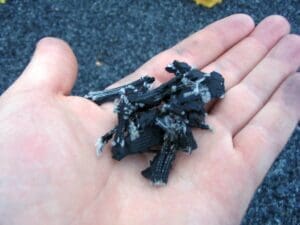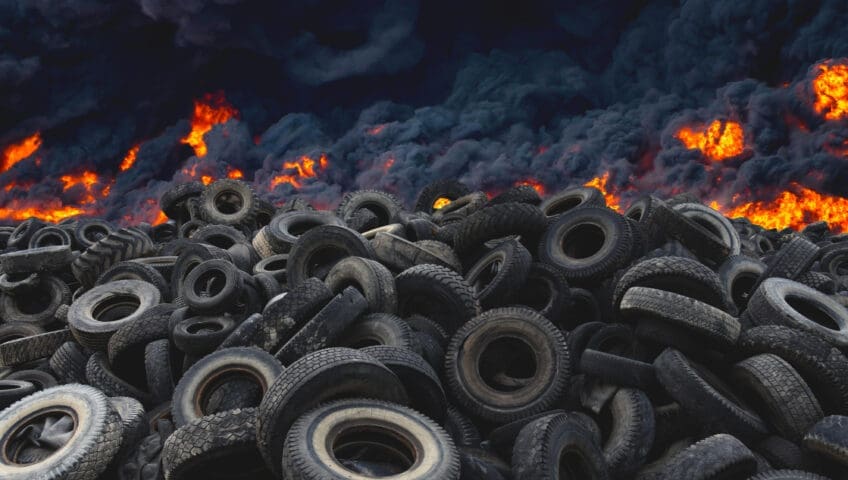Rubber mulch, often touted for its eco-credentials due to its origin from recycled tires, has found a niche in landscaping and playground surfaces. Proponents highlight benefits like unmatched durability, vibrant color retention, and effective weed suppression. However, beneath these apparent advantages lie concerns that cast a long shadow over its desirability and environmental friendliness. As this article from the University of Illinois points out, there are many problems with using old tires for mulch.
Chemical Leaching: Rubber Mulch A Toxic Mess
One of the most alarming issues with rubber mulch is its potential to leach hazardous chemicals into the soil and groundwater. Chemical leaching can harm plant health and poison the garden it was meant to enrich. Heavy metals such as zinc and polycyclic aromatic hydrocarbons (PAHs) are toxic substances that rubber can release. These chemicals are not just harmful to plants; they pose a significant threat to wildlife and can contaminate water sources, impacting ecosystems and human health.
Soil Health: The Missing Link
Soil vitality hinges on organic interplay, something rubber mulch cannot contribute to. Organic mulches decompose, enriching the soil with essential nutrients and improving its structure. This decomposition supports soil fertility and plant growth, fostering a vibrant ecosystem. Rubber mulch, in stark contrast, offers no such benefits. Its inability to break down and add organic matter to the soil results in the gradual degradation of soil quality, affecting the health and growth of plants. If a healthy garden or landscaping is your goal, you should consider alternatives that are better for your soil
Heat Retention: Too Hot to Handle
Rubber mulch’s thermal properties are a double-edged sword. While it may effectively suppress weed growth, its ability to absorb and retain heat surpasses that of organic mulches, leading to significantly higher soil temperatures. This excessive heat can stress and potentially damage plant roots, especially during hot weather, and create uncomfortably hot surfaces in landscaped areas and playgrounds, affecting human comfort and pet safety. Two areas of concern with heat retention are:
- Increased Surface Temperature: Rubber mulch tends to heat up more than organic mulches, especially on sunny days. This can lead to higher surface temperatures that might stress nearby plants and pose risks to children playing on it, as it can become uncomfortably hot to touch (University of Missouri Extension, 2022).
- Impact on Plant Growth: The elevated temperatures can affect plant roots and overall plant health. The heat can cause soil temperatures to rise, potentially stressing plants and affecting their growth.
Fire Hazard: Playing with Fire
Another critical concern is rubber mulch’s flammability. Rubber mulch ignites more readily than wood mulch and burns at much higher temperatures, making fires involving rubber mulch challenging to control and extinguish. This presents a significant safety concern, particularly in dry conditions or areas prone to wildfires, where the use of rubber mulch could exacerbate the risk of fires spreading (University of Illinois Extension, 2020).
Environmental Impact: A Questionable Legacy
The environmental sustainability of using recycled tires as mulch is questionable. Over time, rubber mulch disintegrates into smaller particles that water can carry away, polluting waterways and harming aquatic life. Furthermore, the difficulty in removing and disposing of rubber mulch—which does not decompose—adds to its environmental burden, contributing to landfill waste and diminishing its eco-friendly reputation (U.S. Environmental Protection Agency, 2021).
Health Concerns: Unseen Dangers
The potential health impacts of rubber mulch warrant caution, particularly in playground settings. The risk of children ingesting or inhaling toxic particles and chemicals from rubber mulch raises serious safety concerns. Although research is ongoing, current findings suggest that rubber mulch poses risks to human health, warranting further investigation and caution when choosing materials for playgrounds and gardens (University of California Agriculture and Natural Resources, 2023).
Tough to Work With
Rubber mulch is very tough to work with once it is in place. It doesn’t rake well, the rubber tends to be very difficult to move and remove once it is in place. Rubber’s properties tend to make cleaning out mulch landscaping more difficult with leaves and debris sticking to the mulch making it much harder to clean out (University of Illinois Extension, 2020).
Making Responsible Choices
 While rubber mulch may offer certain practical advantages, its environmental, health, and safety risks make it neither a safe nor responsible choice. Organic mulches such as straw, dye free wood chips, or leaf litter remain the better choice for those committed to ecological sustainability and the health of their garden ecosystems. These natural options enrich the soil, support plant health, and integrate harmoniously with the environment, underscoring the importance of choosing mulch materials that nurture rather than harm our gardens and planet. Barefoot Lawn Care works towards a more sustainable and healthy future. For that reason, we do not include rubber mulch as an option with our mulch service.
While rubber mulch may offer certain practical advantages, its environmental, health, and safety risks make it neither a safe nor responsible choice. Organic mulches such as straw, dye free wood chips, or leaf litter remain the better choice for those committed to ecological sustainability and the health of their garden ecosystems. These natural options enrich the soil, support plant health, and integrate harmoniously with the environment, underscoring the importance of choosing mulch materials that nurture rather than harm our gardens and planet. Barefoot Lawn Care works towards a more sustainable and healthy future. For that reason, we do not include rubber mulch as an option with our mulch service.
References
U.S. Environmental Protection Agency. (2021). Recycled tire crumb rubber: What you need to know.
University of California Agriculture and Natural Resources. (2023). Safety of rubber mulch in playgrounds.
University of Illinois Extension. (2020). The downside of rubber mulch in gardens.
University of Missouri Extension. (2022). Effects of mulch on soil temperature and plant growth.

